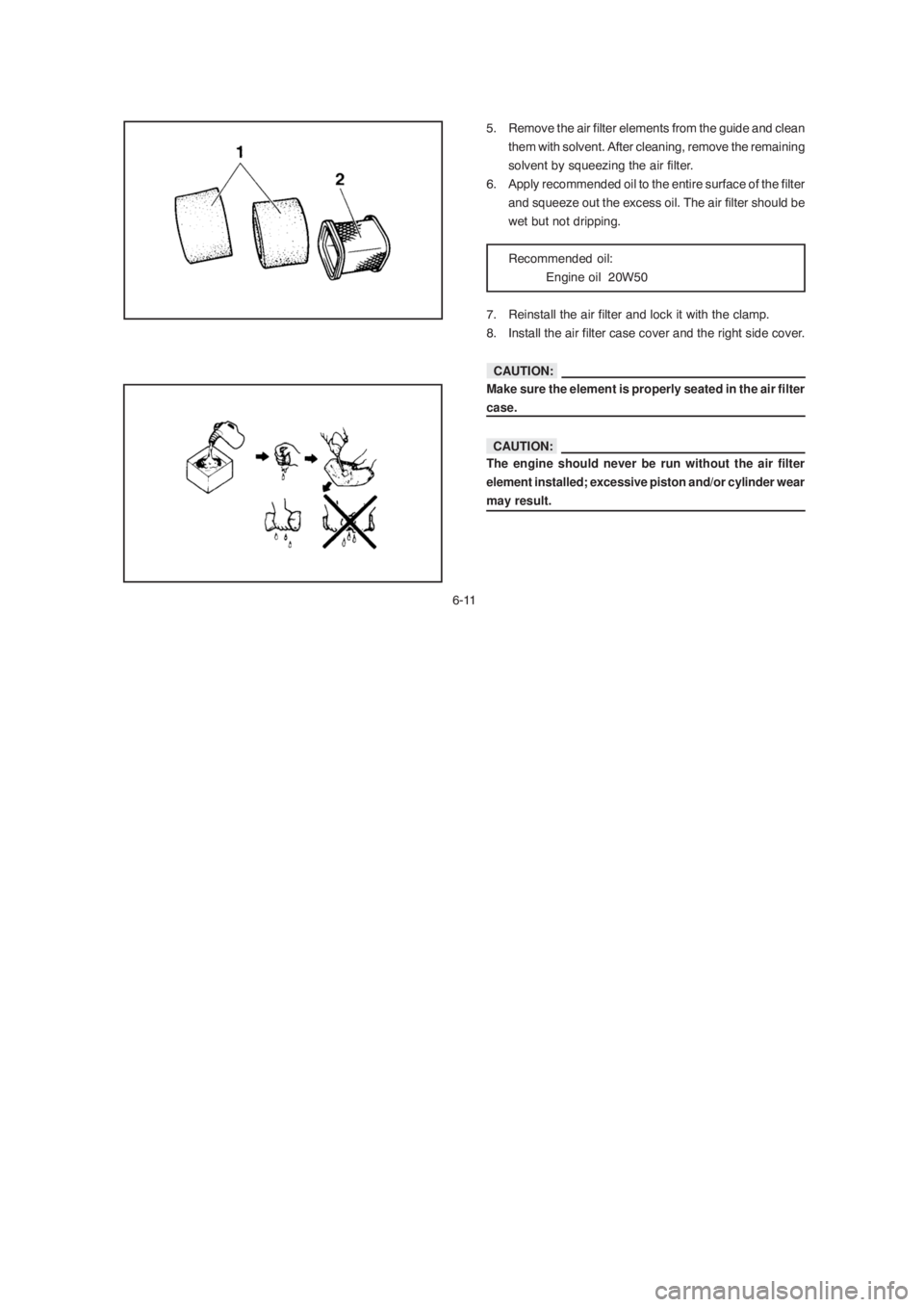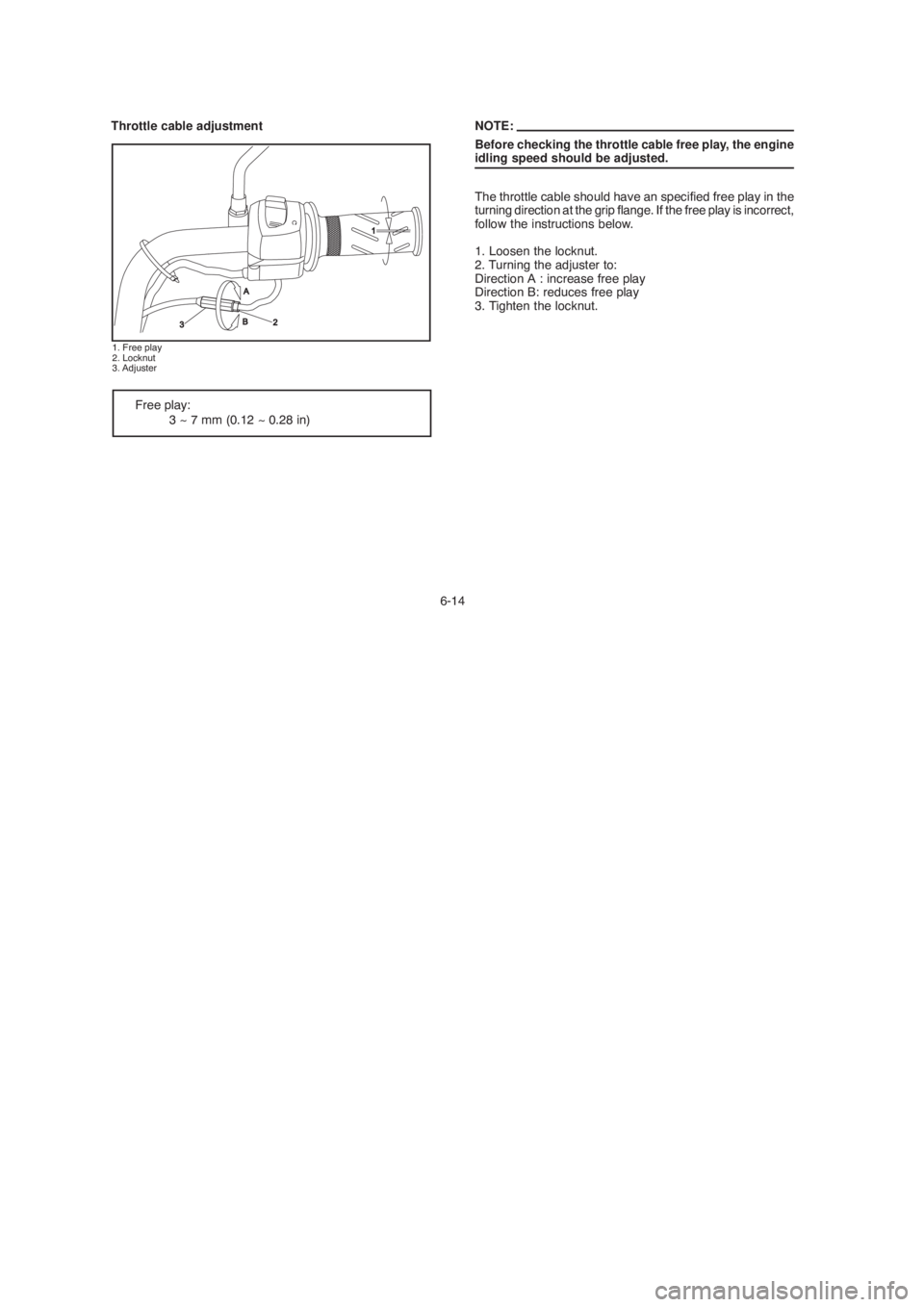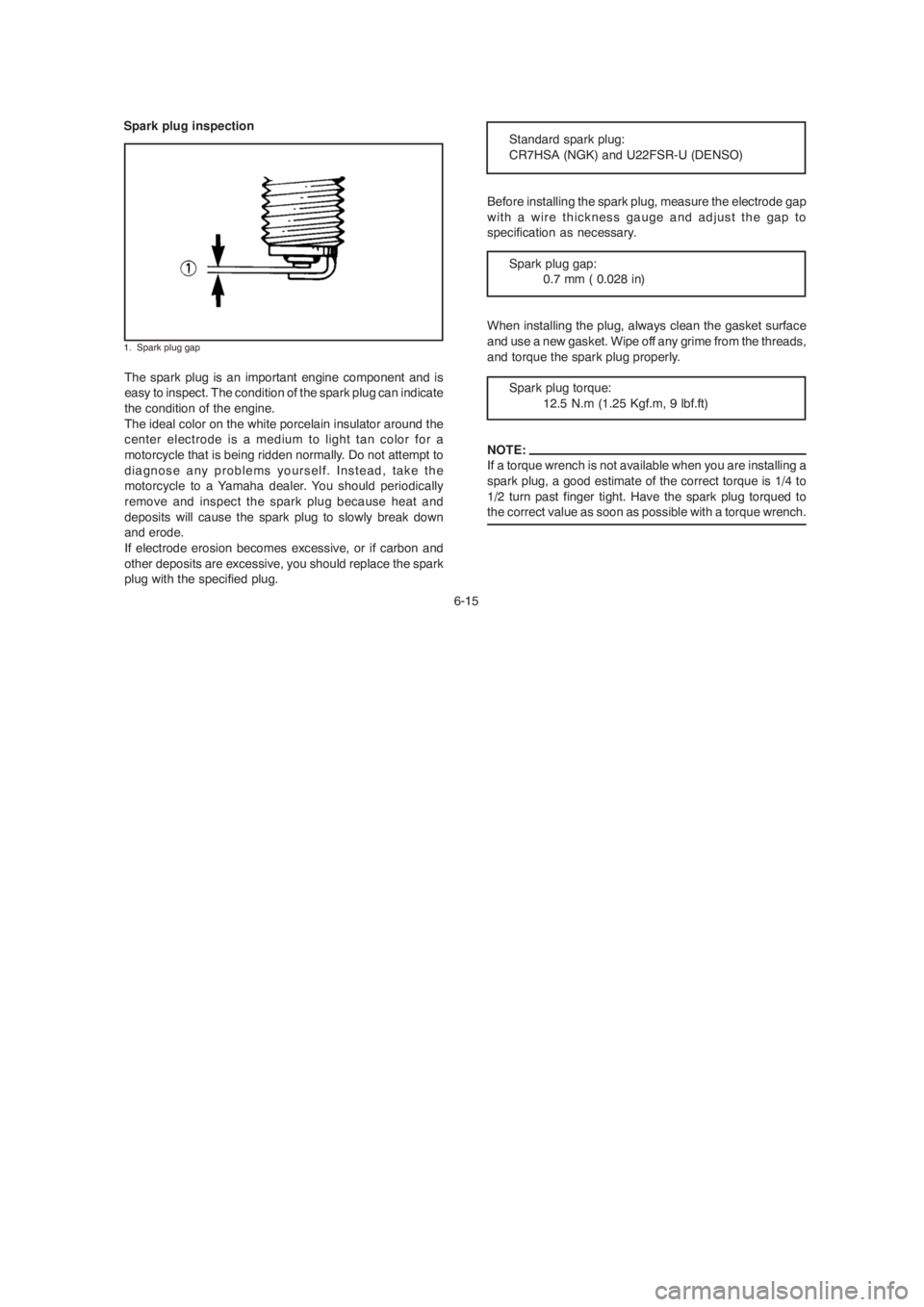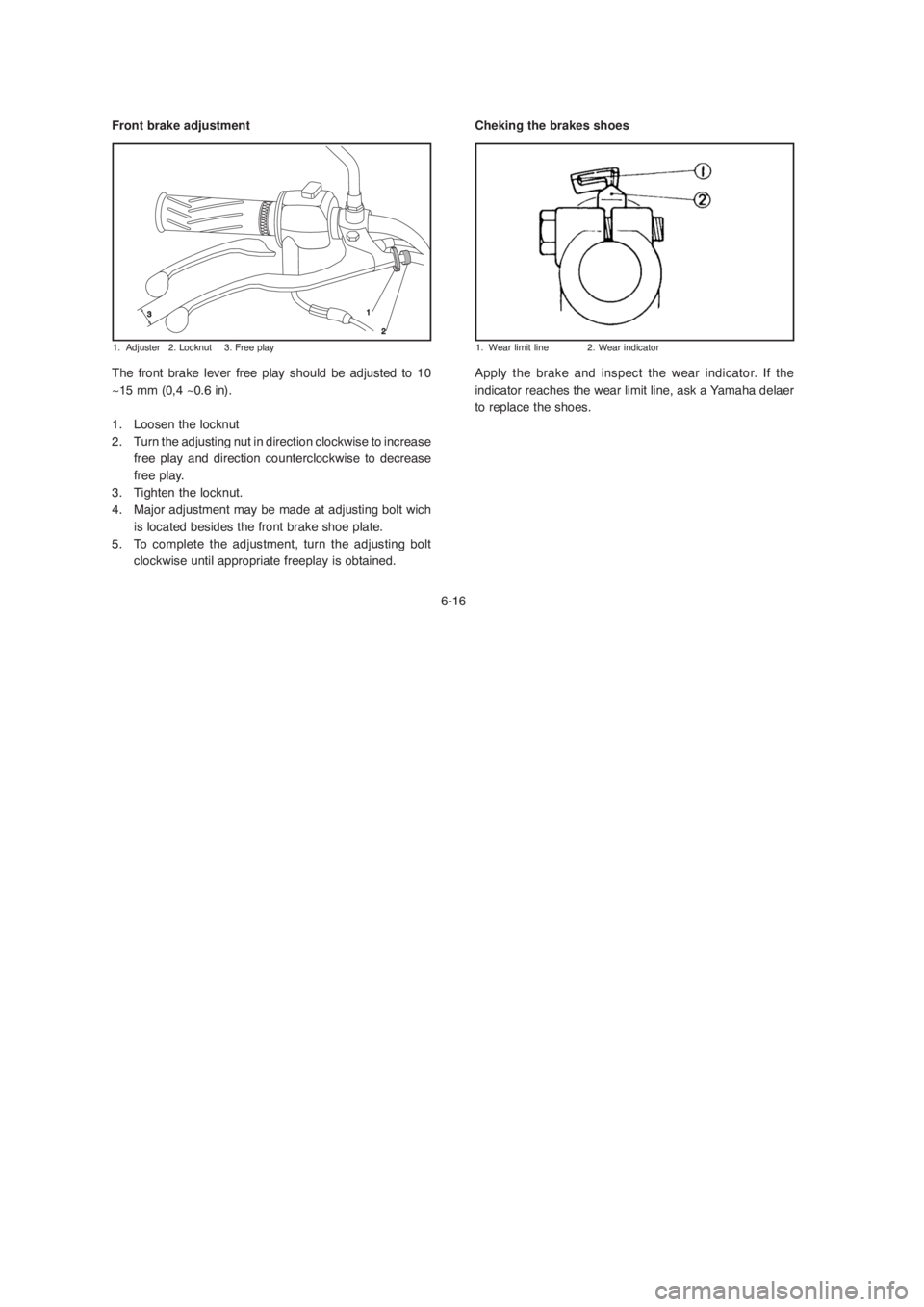Page 49 of 83
6-9 Oil pressure
1. Remove the check bolt 1 in the cylinder head.
2. Start the engine and keep it idling until oil flows out
of the bleed hole. If no oil comes out after one
minute, turn off the engine immediately so it will
not seize. In such a case go to the nearest Yamaha
dealer or other qualified mechanic for repairs.
3. After checking, tighten the check bolt to the
specified torque.
Check bolt torque:
7 N.m (0.7 Kgf.m, 5.0 lbf.ft)
1. Check bolt
6-9 Oil pressure
1. Remove the check bolt 1 in the cylinder head.
2. Start the engine and keep it idling until oil flows out
of the bleed hole. If no oil comes out after one
minute, turn off the engine immediately so it will
not seize. In such a case go to the nearest Yamaha
dealer or other qualified mechanic for repairs.
3. After checking, tighten the check bolt to the
specified torque.
Check bolt torque:
7 N.m (0.7 Kgf.m, 5.0 lbf.ft)
1. Check bolt
Page 50 of 83
6-10Air filter
The air filter should be cleaned at the specified intervals.
It should be cleaned more frequently if you are riding in
unusually wet or dusty areas.
1. Remove the right side cover.(pag. 3-13)
2. Remove the air filter case cover by removing the bolts.
3. Remove the clamp.
4. Remove the air filter from the case.
6-10Air filter
The air filter should be cleaned at the specified intervals.
It should be cleaned more frequently if you are riding in
unusually wet or dusty areas.
1. Remove the right side cover.(pag. 3-13)
2. Remove the air filter case cover by removing the bolts.
3. Remove the clamp.
4. Remove the air filter from the case.
Page 51 of 83

5. Remove the air filter elements from the guide and clean
them with solvent. After cleaning, remove the remaining
solvent by squeezing the air filter.
6. Apply recommended oil to the entire surface of the filter
and squeeze out the excess oil. The air filter should be
wet but not dripping.
Recommended oil:
Engine oil 20W50
7. Reinstall the air filter and lock it with the clamp.
8. Install the air filter case cover and the right side cover.
Make sure the element is properly seated in the air filter
case.
The engine should never be run without the air filter
element installed; excessive piston and/or cylinder wear
may result.
6-11
CAUTION:
CAUTION:
5. Remove the air filter elements from the guide and clean
them with solvent. After cleaning, remove the remaining
solvent by squeezing the air filter.
6. Apply recommended oil to the entire surface of the filter
and squeeze out the excess oil. The air filter should be
wet but not dripping.
Recommended oil:
Engine oil 20W50
7. Reinstall the air filter and lock it with the clamp.
8. Install the air filter case cover and the right side cover.
Make sure the element is properly seated in the air filter
case.
The engine should never be run without the air filter
element installed; excessive piston and/or cylinder wear
may result.
6-11
CAUTION:
CAUTION:
Page 52 of 83

Valve clearance adjustment
The correct valve clearance changes with use, resulting in
improper fuel/air supply or engine noise. To prevent this,
valve clearance must be adjusted regularly. This adjustment,
however, should be left to a professional Yamaha service
technician. Carburetor adjustment
The carburetor is a vital part of the engine. Adjusting should
be left to a Yamaha dealer who has the professional
knowledge, specialized data, and equipment to do so
properly. However, the following may be serviced by the
owner as part of routine maintenance.
The carburetor was set at Yamaha factory after many
tests. If the settings are changed, poor engine
performance and damage may result.
6-12
CAUTION:
Valve clearance adjustment
The correct valve clearance changes with use, resulting in
improper fuel/air supply or engine noise. To prevent this,
valve clearance must be adjusted regularly. This adjustment,
however, should be left to a professional Yamaha service
technician. Carburetor adjustment
The carburetor is a vital part of the engine. Adjusting should
be left to a Yamaha dealer who has the professional
knowledge, specialized data, and equipment to do so
properly. However, the following may be serviced by the
owner as part of routine maintenance.
The carburetor was set at Yamaha factory after many
tests. If the settings are changed, poor engine
performance and damage may result.
6-12
CAUTION:
Page 53 of 83

NOTE:
A diagnostic tachometer must be used for this procedure.
1. Attach the tachometer. Start the engine and warm it up
for a few minutes (normally, 1 or 2 minutes) at
approximately 1,000 to 2,000 r/min. Occasionally rev
the engine to 4,000 to 5,000 r/min. The engine is warm
when it quickly responds to the throttle.
2. Set the idle to the specified engine speed by adjusting
the throttle stop screw; turn the screw in to increase
engine speed and out to decrease engine speed.
NOTE:
If the specified idle speed cannot be obtained by performing
the above adjustment, consult a Yamaha dealer.
6-13
Standard idle speed:
1,300 ~ 1,400 r/min
1. Throttle stop screw
Idle speed adjustment
NOTE:
A diagnostic tachometer must be used for this procedure.
1. Attach the tachometer. Start the engine and warm it up
for a few minutes (normally, 1 or 2 minutes) at
approximately 1,000 to 2,000 r/min. Occasionally rev
the engine to 4,000 to 5,000 r/min. The engine is warm
when it quickly responds to the throttle.
2. Set the idle to the specified engine speed by adjusting
the throttle stop screw; turn the screw in to increase
engine speed and out to decrease engine speed.
NOTE:
If the specified idle speed cannot be obtained by performing
the above adjustment, consult a Yamaha dealer.
6-13
Standard idle speed:
1,300 ~ 1,400 r/min
1. Throttle stop screw
Idle speed adjustment
Page 54 of 83

NOTE:
Before checking the throttle cable free play, the engine
idling speed should be adjusted.
The throttle cable should have an specified free play in the
turning direction at the grip flange. If the free play is incorrect,
follow the instructions below.
1. Loosen the locknut.
2. Turning the adjuster to:
Direction A : increase free play
Direction B: reduces free play
3. Tighten the locknut.
6-14
Free play:
3 ~ 7 mm (0.12 ~ 0.28 in) Throttle cable adjustment
1. Free play
2. Locknut
3. Adjuster
NOTE:
Before checking the throttle cable free play, the engine
idling speed should be adjusted.
The throttle cable should have an specified free play in the
turning direction at the grip flange. If the free play is incorrect,
follow the instructions below.
1. Loosen the locknut.
2. Turning the adjuster to:
Direction A : increase free play
Direction B: reduces free play
3. Tighten the locknut.
6-14
Free play:
3 ~ 7 mm (0.12 ~ 0.28 in) Throttle cable adjustment
1. Free play
2. Locknut
3. Adjuster
Page 55 of 83

6-15
1. Spark plug gap
Spark plug inspection
The spark plug is an important engine component and is
easy to inspect. The condition of the spark plug can indicate
the condition of the engine.
The ideal color on the white porcelain insulator around the
center electrode is a medium to light tan color for a
motorcycle that is being ridden normally. Do not attempt to
diagnose any problems yourself. Instead, take the
motorcycle to a Yamaha dealer. You should periodically
remove and inspect the spark plug because heat and
deposits will cause the spark plug to slowly break down
and erode.
If electrode erosion becomes excessive, or if carbon and
other deposits are excessive, you should replace the spark
plug with the specified plug.Standard spark plug:
CR7HSA (NGK) and U22FSR-U (DENSO)
Before installing the spark plug, measure the electrode gap
with a wire thickness gauge and adjust the gap to
specification as necessary.
Spark plug gap:
0.7 mm ( 0.028 in)
When installing the plug, always clean the gasket surface
and use a new gasket. Wipe off any grime from the threads,
and torque the spark plug properly.
Spark plug torque:
12.5 N.m (1.25 Kgf.m, 9 lbf.ft)
NOTE:
If a torque wrench is not available when you are installing a
spark plug, a good estimate of the correct torque is 1/4 to
1/2 turn past finger tight. Have the spark plug torqued to
the correct value as soon as possible with a torque wrench.
6-15
1. Spark plug gap
Spark plug inspection
The spark plug is an important engine component and is
easy to inspect. The condition of the spark plug can indicate
the condition of the engine.
The ideal color on the white porcelain insulator around the
center electrode is a medium to light tan color for a
motorcycle that is being ridden normally. Do not attempt to
diagnose any problems yourself. Instead, take the
motorcycle to a Yamaha dealer. You should periodically
remove and inspect the spark plug because heat and
deposits will cause the spark plug to slowly break down
and erode.
If electrode erosion becomes excessive, or if carbon and
other deposits are excessive, you should replace the spark
plug with the specified plug.Standard spark plug:
CR7HSA (NGK) and U22FSR-U (DENSO)
Before installing the spark plug, measure the electrode gap
with a wire thickness gauge and adjust the gap to
specification as necessary.
Spark plug gap:
0.7 mm ( 0.028 in)
When installing the plug, always clean the gasket surface
and use a new gasket. Wipe off any grime from the threads,
and torque the spark plug properly.
Spark plug torque:
12.5 N.m (1.25 Kgf.m, 9 lbf.ft)
NOTE:
If a torque wrench is not available when you are installing a
spark plug, a good estimate of the correct torque is 1/4 to
1/2 turn past finger tight. Have the spark plug torqued to
the correct value as soon as possible with a torque wrench.
Page 56 of 83

6-16
Front brake adjustment
1. Adjuster 2. Locknut 3. Free play
The front brake lever free play should be adjusted to 10
~15 mm (0,4 ~0.6 in).
1. Loosen the locknut
2. Turn the adjusting nut in direction clockwise to increase
free play and direction counterclockwise to decrease
free play.
3. Tighten the locknut.
4. Major adjustment may be made at adjusting bolt wich
is located besides the front brake shoe plate.
5. To complete the adjustment, turn the adjusting bolt
clockwise until appropriate freeplay is obtained.
Cheking the brakes shoes
1. Wear limit line 2. Wear indicator
Apply the brake and inspect the wear indicator. If the
indicator reaches the wear limit line, ask a Yamaha delaer
to replace the shoes.
6-16
Front brake adjustment
1. Adjuster 2. Locknut 3. Free play
The front brake lever free play should be adjusted to 10
~15 mm (0,4 ~0.6 in).
1. Loosen the locknut
2. Turn the adjusting nut in direction clockwise to increase
free play and direction counterclockwise to decrease
free play.
3. Tighten the locknut.
4. Major adjustment may be made at adjusting bolt wich
is located besides the front brake shoe plate.
5. To complete the adjustment, turn the adjusting bolt
clockwise until appropriate freeplay is obtained.
Cheking the brakes shoes
1. Wear limit line 2. Wear indicator
Apply the brake and inspect the wear indicator. If the
indicator reaches the wear limit line, ask a Yamaha delaer
to replace the shoes.